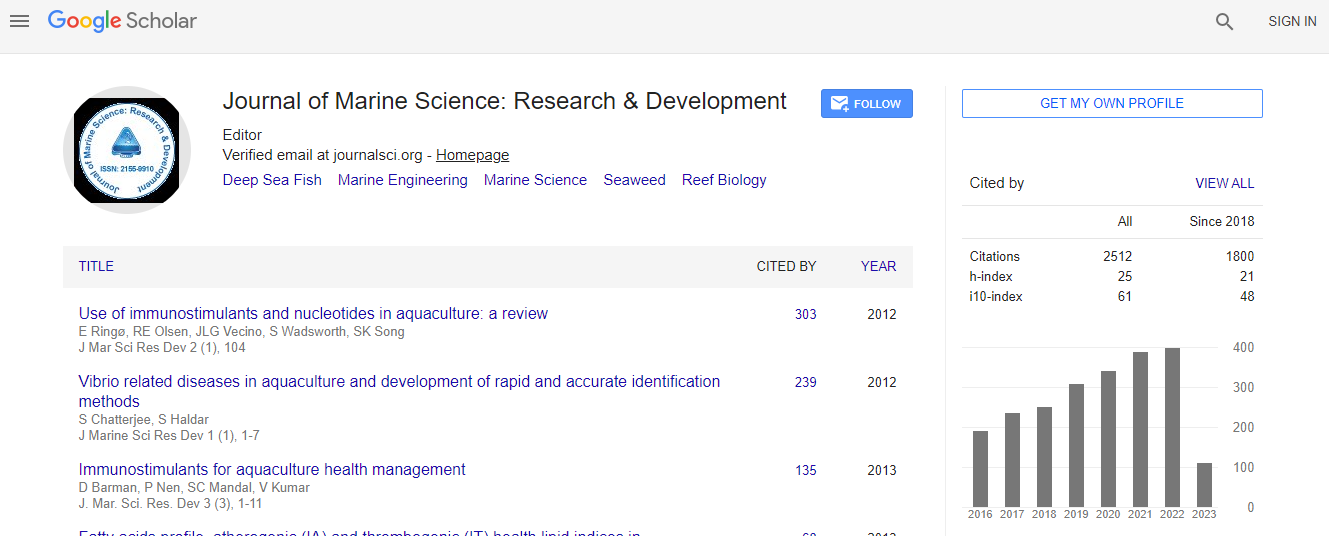Research Article
Biochemical Compositions of Seaweeds Collected from Olaikuda and Vadakkadu, Rameshwaram, Southeast Coast of India
Suparna Roy* and Anantharaman PCentre of Advanced Study in Marine Biology, Annamalai University, Tamilnadu, India
- Corresponding Author:
- Suparna Roy
Centre of Advanced Study in Marine Biology
Faculty of Marine Sciences, Annamalai University
Annamalai Nagar, Tamilnadu, India
Tel: +91-9443043597
E-mail: suparna09roy@gmail.com
Received Date: September 08, 2017; Accepted Date: October 03, 2017; Published Date: October 06, 2017
Citation: Roy S,Anantharaman P (2017) Biochemical Compositions of Seaweeds Collected from Olaikuda and Vadakkadu, Rameshwaram, Southeast Coast of India. J Marine Sci Res Dev 7:240. doi:10.4172/2155-9910.1000240
Copyright: © 2017 Roy S, et al. This is an open-access article distributed under the terms of the Creative Commons Attribution License, which permits unrestricted use, distribution, and reproduction in any medium, provided the original author and source are credited.
Abstract
Some seaweed has been used as an important source of commercial application of phycocolloids, agar, and alginate consequently some seaweeds have also been utilized as food and food ingredients due to their high nutritive compositions such as carbohydrates, protein, lipid, amino acids, fatty acids, fibre and minerals. In different countries, including India, seaweeds are gradually taking place as food items in the market, so their biochemical components analysis will decipher their nutritional implications. In this investigation, total 33 species of seaweeds were collected from the southeast coast of India and analyzed for their biochemical composition such as carbohydrate including glucose and starch, protein and lipid. The carbohydrate content varied from 15.20 ± 0.69 mg/gm dry weight (Padina boergesenii) to 97.69 ± 2.3 mg/gm dry wt (Gracilaria edulis). The carbohydrate content of red seaweeds was comparably higher than green and brown seaweeds. The protein content was minimum in Cystoseira indica (76.23 ± 0.21 mg/gm dry wt) and maximum in Amphiroa anceps (96.06 ± 0.95 mg/gm dry wt) and lipid content was comparatively high in Valoniopsis pachynema (82.33 ± 2.51 mg/gm dry wt) and Caulerpa racemosa (81.06 ± 0.37 mg/gm dry wt). The glucose content was high in Digenea simplex (0.78 ± 0.004 mg/gm dry wt) followed by Laurencia papillosa (0.61 ± 0.08 mg/gm dry wt) likewise starch content was also high in Digenea simplex (0.72 ± 0.01 mg/gm dry wt) and Laurencia papillosa (0.54 ± 0.00 mg/gm dry wt). From this study, it was concluded that the above mentioned seaweeds will be used as food after further more detailed analysis of the other biochemical components.

 Spanish
Spanish  Chinese
Chinese  Russian
Russian  German
German  French
French  Japanese
Japanese  Portuguese
Portuguese  Hindi
Hindi 